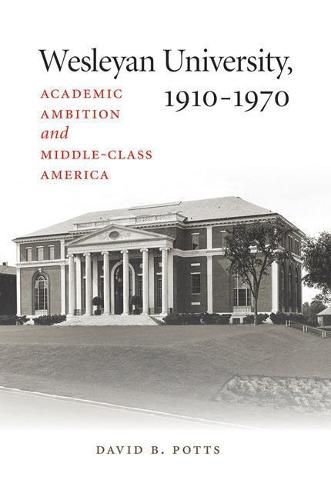Readings Newsletter
Become a Readings Member to make your shopping experience even easier.
Sign in or sign up for free!
You’re not far away from qualifying for FREE standard shipping within Australia
You’ve qualified for FREE standard shipping within Australia
The cart is loading…






In Wesleyan University, 1910 - 1970, David B. Potts presents an engaging story that includes a measured departure from denominational identity, an enterprising acquisition of fabulous wealth, and a burst of enthusiastic aspirations that initiated an era of financial stress. Threaded through these episodes is a commitment to social service that is rooted in Methodism and clothed in more humanistic garb after World War II.
Potts gives an unprecedented level of attention to the board of trustees and finances. These closely related components are now clearly introduced as major shaping forces in the development of American higher education. Extensive examination is also given to student and faculty roles in building and altering institutional identity. Threaded throughout these probes within in the analytical narrative is a close look at the waxing and waning of presidential leadership.
All these developments, as is particularly evident in the areas of student demography and faculty compensation, travel on a pathway through middle-class America. Within this broad context, Wesleyan becomes a window on how the nation’s liberal arts colleges survived and thrived during the last century. This book concludes the author’s analysis of changes in institutional identities that shaped the narrative for his widely praised first volume, Wesleyan University, 1831 - 1910: Collegiate Enterprise in New England. His current fully evidenced sequel supplies helpful insights and reference points as we encounter the present fiscal strain in higher education and the related debates on institutional mission.
$9.00 standard shipping within Australia
FREE standard shipping within Australia for orders over $100.00
Express & International shipping calculated at checkout
In Wesleyan University, 1910 - 1970, David B. Potts presents an engaging story that includes a measured departure from denominational identity, an enterprising acquisition of fabulous wealth, and a burst of enthusiastic aspirations that initiated an era of financial stress. Threaded through these episodes is a commitment to social service that is rooted in Methodism and clothed in more humanistic garb after World War II.
Potts gives an unprecedented level of attention to the board of trustees and finances. These closely related components are now clearly introduced as major shaping forces in the development of American higher education. Extensive examination is also given to student and faculty roles in building and altering institutional identity. Threaded throughout these probes within in the analytical narrative is a close look at the waxing and waning of presidential leadership.
All these developments, as is particularly evident in the areas of student demography and faculty compensation, travel on a pathway through middle-class America. Within this broad context, Wesleyan becomes a window on how the nation’s liberal arts colleges survived and thrived during the last century. This book concludes the author’s analysis of changes in institutional identities that shaped the narrative for his widely praised first volume, Wesleyan University, 1831 - 1910: Collegiate Enterprise in New England. His current fully evidenced sequel supplies helpful insights and reference points as we encounter the present fiscal strain in higher education and the related debates on institutional mission.